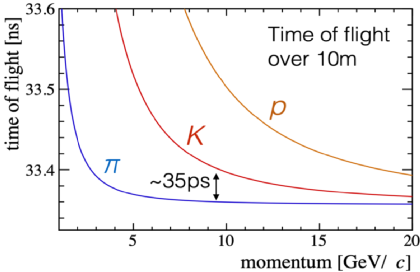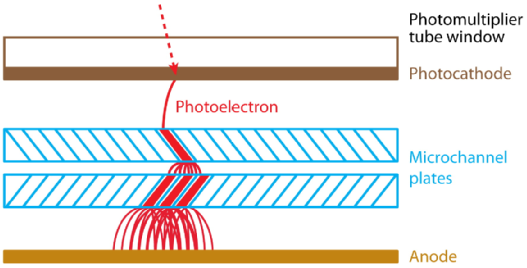Alex Davidson
I am a first year PhD CASE Student in the LHCb Elementary Particle Physics Group at Warwick, working in a partnership with Photek Limited a specialist manufacturer of vacuum-based tubes and camera systems.
Developing the next generation of fast-timing photon Detectors
My project is studying the behaviour of micro-channel-plate photodetectors (MCP PMT), in an environment with high occupancy. The project focuses on the use of these detectors in TORCH (Time of Internally Reflected Cherenkov light detector), a proposed time-of-flight detector to be installed as part of a upgrade of the LHCb experiment. TORCH will be implemented to improve particle identification of kaons, pions and protons at low momentum (<10GeV/c) (1). Due to their different masses these particles will travel at different speeds reaching a quartz radiator bar at different times. Once inside, Cherenkov photons are produced as the particles travel faster than light in this medium. These photons are transported by total internal reflection towards an array of MCP PMT's where the arrival time is measured. The TOF difference between kaons and pions with momentum of 10 GeV/c over 10 m distance is about 35 ps as seen in figure 1. To achieve separation of three standard deviations between kaons and pions, requires a time resolution of 10–15 ps. With ∼ 30 photons detected per kaon/pion track this gives a target time resolution of 70 ps.

Figure 1) Time of fight for π, K,p as function of momentum with a flight time of 10m
Micro-channel-plate photomultipliers
MCP PMT`s are fabricated to have a high secondary electron yield, so that a single photoelectron from the cathode produces an avalanche of electrons in the micro channel pore as seen in figure 2. The electrons are accelerated through high electric fields so that an electronic signal can be seen by the anode (2).
Figure 2) Side view layout of an MCP PMT showing how one photon incident onto the photocathode produces an avalanche of electrons impacting on the anode.
I am using finite element analysis simulation to understand the internal electrodynamic physics of the device to further optimise the MCP PMT design and to understand the spread of the electrons limiting the resolution of the device. If the rate of photoelectons increases due to high occupancy or event rate, this leads to saturation of the signal and, if left at this state, a reduction of devices’ lifetime. In my second year, I will be traveling to Photek's headquarters to look into ways the device may be fabricated to improve the lifetime and rate capability.
Undergraduate Teaching
I mark and demonstrate the First year undergraduate lab module: PX152 and helped demonstrate the 2nd Year Microprocessors Lab.
References
Course [1] S.Bhasin et al 2023. Performance of a prototype torch time-of-flight detector, Nuclear Instruments and Methods in Physics Research Section A: Accelerators, Spectrometers, Detectors and Associated Equipment https://arxiv.org/abs/2209.13379
[2] P. Krizan and S. Korpar, Photodetectors in Particle Physics Experiments, Ann. Rev. Nucl. Part. Sci. 63 (2013) 329
Contact Details:
Office: PS001
E-Mail:


